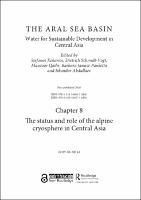Chapter 8 The Status and Role of the alpine Cryosphere in Central Asia
Proposal review
| dc.contributor.author | Hoelzle, Martin | |
| dc.contributor.author | Barandun, Martina | |
| dc.contributor.author | Bolch, Tobias | |
| dc.contributor.author | Fiddes, Joel | |
| dc.contributor.author | Gafurov, Abror | |
| dc.contributor.author | Muccione, Veruska | |
| dc.contributor.author | Saks, Tomas | |
| dc.contributor.author | Shahgedanova, Maria | |
| dc.contributor.editor | Smakhtin, Vladimir | |
| dc.date.accessioned | 2019-10-31 11:51:14 | |
| dc.date.accessioned | 2020-04-01T09:56:26Z | |
| dc.date.available | 2020-04-01T09:56:26Z | |
| dc.date.issued | 2019 | |
| dc.identifier | 1005783 | |
| dc.identifier | OCN: 1135850118 | en_US |
| dc.identifier.uri | http://library.oapen.org/handle/20.500.12657/24348 | |
| dc.description.abstract | The alpine cryosphere including snow, glaciers and permafrost are critical to water management in the Aral Sea Basin (ASB) and larger Central Asia (CA) under changing climate: as they store large amounts of water in its solid forms. Most cryospheric components in the Aral Sea Basin are close to melting point, and hence very vulnerable to a slight increase in air temperature with significant consequences to long-term water availability and to water resources variability and extremes. Current knowledge about different components of cryosphere and their connection to climate in the Basin and in the entire Central Asia, varies. While it is advanced in the topics of snow and glaciers, knowledge on permafrost it rather limited. Observed trends in runoff point in the direction of increasing water availability in July and August at least until mid-century and increasing possibility for water storage in reservoirs and aquifers. However, eventually this will change as glaciers waste away. Future runoff may change considerably after mid-century and start to decline if not compensated by increasing precipitation. Cryosphere monitoring systems are the basis for sound estimates of water availability and water-related hazards associated with snow, glaciers and permafrost. They require a well-distributed observational network for all cryospheric variables. Such systems need to be re-established in the Basin after the breakup of the Soviet Union in the early 1990s. This process is slowly emerging in the region. Collaboration between local operational hydro-meteorological services and academic sector, and with international research networks may improving the observing capabilities in high mountain regions of CA Asia in general and the ASB specifically. | |
| dc.language | English | |
| dc.subject.classification | thema EDItEUR::R Earth Sciences, Geography, Environment, Planning::RB Earth sciences::RBK Hydrology and the hydrosphere | en_US |
| dc.subject.classification | thema EDItEUR::R Earth Sciences, Geography, Environment, Planning::RG Geography::RGC Human geography | en_US |
| dc.subject.classification | thema EDItEUR::R Earth Sciences, Geography, Environment, Planning::RN The environment::RNC Applied ecology | en_US |
| dc.subject.classification | thema EDItEUR::T Technology, Engineering, Agriculture, Industrial processes::TQ Environmental science, engineering and technology | en_US |
| dc.subject.other | Alpine Crosphere | |
| dc.subject.other | River Basin | |
| dc.subject.other | Amu Darya | |
| dc.subject.other | Syr Darya | |
| dc.subject.other | Central Asia | |
| dc.subject.other | Water Resource Management | |
| dc.subject.other | Hydrology | |
| dc.subject.other | Environmental Policy | |
| dc.subject.other | Sustainable Development | |
| dc.title | Chapter 8 The Status and Role of the alpine Cryosphere in Central Asia | |
| dc.type | chapter | |
| oapen.relation.isPublishedBy | 7b3c7b10-5b1e-40b3-860e-c6dd5197f0bb | |
| oapen.relation.isPartOfBook | 7dd38d57-494e-4aa0-8cde-0dbd6bd76d16 | |
| oapen.relation.isbn | 9780429436475 | |
| oapen.imprint | Routledge | |
| oapen.pages | 23 | |
| oapen.remark.public | 3-8-2020 - No DOI registered in CrossRef for ISBN 9781138348882 | |
| oapen.identifier.ocn | 1135850118 | |
| peerreview.anonymity | Single-anonymised | |
| peerreview.id | bc80075c-96cc-4740-a9f3-a234bc2598f1 | |
| peerreview.open.review | No | |
| peerreview.publish.responsibility | Publisher | |
| peerreview.review.stage | Pre-publication | |
| peerreview.review.type | Proposal | |
| peerreview.reviewer.type | Internal editor | |
| peerreview.reviewer.type | External peer reviewer | |
| peerreview.title | Proposal review | |
| oapen.review.comments | Taylor & Francis open access titles are reviewed as a minimum at proposal stage by at least two external peer reviewers and an internal editor (additional reviews may be sought and additional content reviewed as required). |

